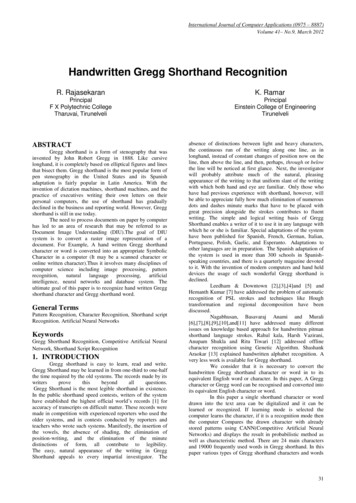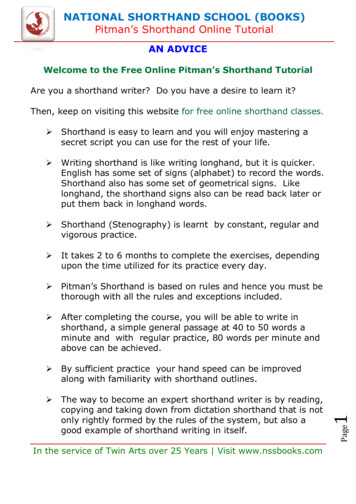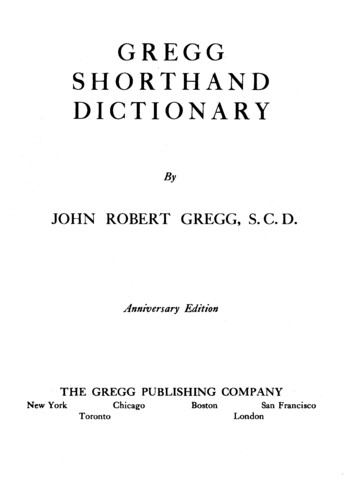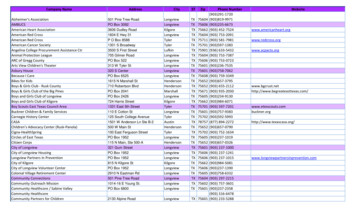
Transcription
The Basic Principles ofGregg ShorthandDr. John Robert Gregg(1867–1948)“Art must have a scientific basis. Shorthand not only has this scientificbasis, but it is a science in and of itself.”—Isaac S. Dement
2PrefaceC by a new invention an American almost invariably asks: “Will it work?” Untilsatisfied on that point, he is seldom interested in the mechanical principles on which the invention is constructed. But when the invention has been demonstrated to be a real advance, hewants to take the motor apart to see how it works.This will explain why so little has been written about the scientific basis of Gregg Shorthand.The policy pursued in presenting the claims of the system was that of concentrating attention onthe results accomplished by its students and writers. Even after Gregg Shorthand had achievedthe most extraordinary success ever attained by any system in the history of shorthand, I was toobusily engaged in the production of textbooks and magazines, and in the building of a publishingorganization, to respond to the demand for a detailed explanation of the scientific principles onwhich the system was constructed. At odd moments, as opportunity offered and as the mooddictated, I made shorthand notations for a series of articles on the subject. A few of the articleswere published in the Gregg Shorthand Magazine (England) some years ago, but the reduction inthe size of that magazine on account of war conditions rendered it necessary to discontinue theseries. Since then so many teachers and writers of the system, on both sides of the Atlantic, haveurged me to complete the series that I decided to do so, and to publish them in book form.The fact that the articles were first written for a magazine published in England will explain toAmerican readers the numerous references to Isaac Pitman Shorthand, a system which is nowlittle used in America outside of New York City and some parts of Canada, and also why so manyquotations from well-known authors and writers of other systems are used in support of eachprinciple expounded. In giving these quotations I had in mind the fact that in England there ismore reverence for “precedent” and “authority” than is the case in this country.After reading this book in proof form, one of the most capable supporters of our system said:“The explanation of curvilineal motion as a basic principle in the construction of the system wasa revelation to me. What puzzles me is why you made that feature so prominent in the Preface ofyour very first edition and have practically ignored it in recent editions.”The explanation I gave was that for many years my problem was to “convert” teachers ofother systems, and in doing this I found it best to move along the lines of least resistance by dealing chiefly with things that were familiar to writers and teachers of the older systems. In discussing the system question I began, for example, with the elimination of shading or thickening. Asall teachers and writers of the old-style systems had experienced the difficulty of observing thedistinction between thick and thin characters, and knew that the thickening of a character was anobstacle to rapid writing, they were willing to admit that the elimination of thickened characterswould be an advantage, “other things being equal.”The next step was to explain that the vowels were written in the outline. The difficulty of inserting vowels after the “consonantal skeleton” had been written, and the difficulty of reading
3shorthand when the vowels were omitted, were so obvious that most teachers were willing toadmit with the usual qualifying expression that the insertion of the vowels would be an advantage.The third step was to gain an admission that the placing of words in various positions withrelation to the line was an obstacle to rapid writing and to phrase-writing. This generally elicitedthe most hearty expressions of concurrence of any principle presented.Up to this point we were dealing with things that were familiar to them. When I attempted togo beyond these three principles, I found that Bagehot was right when he said, “One of the greatest pains to humanity is the pain of a new idea. It is so ‘upsetting'—you do not know at oncewhich of your old ideas it will or will not turn out.”Much experience convinced me that it was a mistake in tactics to dwell very long upon theother principles of the system, such as the Longhand Movement, Curvilineal Motion, or Lineality,except perhaps in an incidental way. Any stress placed upon features of the system that were absolutely new and unfamiliar to teachers and writers of the old-style systems would be so “upsetting” and confusing to them, and therefore so provocative of argument, as to nullify the progressmade up to that point.The objective to be gained was the creation of a desire to study the system. To accomplish thisit was best to show them how the system eliminated certain specific difficulties or defects in thesystem they used. If they did study the system, the advantages obtained from the other featuresof the system would gradually, but inevitably, become clear to them as soon as they could writethe system on connected matter.In reading this, many hundreds of teachers and writers of the system who formerly wroteother systems will doubtless remember the various mental reactions which occurred during theperiod of transition from the Old to the New, and will smile appreciatively at this explanation ofthe process.As these articles have been written at various times, and sometimes under pressure, they maylack the unity of plan and treatment which is desirable in a work of this kind. I believe, however,that those interested in shorthand as an art and a science will find them helpful in tracing theprocess of the evolution of the art of shorthand toward principles that are logical and natural tothe mind and characters and movements that are natural to the hand.J R G New York,
4Chapter 1Longhand as a Basis of Shorthand I am persuaded that the true progress of shorthand—the real solution of thedifficulties surrounding it—is to be found in an attentive study of our ordinarylonghand writing. a—T A , in History of Shorthand ( )I reading some of the letters which were received while I was on a trip to Australia, I found avery interesting paragraph in a letter from Mr. John A. Bell of Glasgow.As the paragraph in Mr. Bell’s letter suggests an interesting topic, I am going to use it as a text,as it were, for the first of a series of articles on the scientific principles underlying the system. Mr.Bell writes: In reading over this month’s Magazine I could not but admire the beautifullywritten page on the Fauna of the Alps. I remember when I was studying architecture for an art certificate a number of years ago being struck by a remark made bya writer who was comparing Greek and Roman architecture. He said that the reason why Greek architecture was more beautiful than Roman was that it was basedon the ellipse, which, on account of its variety, is impelling to the eye. Do you seethe point? That is the reason for the pleasure which a page of Gregg gives if onehas looked over several pages of Pitman. aIt is needless to say that, like Mr. Bell, every writer of the system finds delight in the artisticbeauty of its forms and in the easy, natural character of the writing. These qualities are commented on again and again in the letters we receive. But doubtless few writers have tried, as Mr.Bell has done, to find definite reasons for either the artistic qualities of the system or its easywriting qualities.As the derivation of them may be interesting to our friends, I am going to discuss them in aseries of articles. In doing this I intend, first, to explain the general basic principles of the system,and, second, to show how these fundamental principles have been applied in the selection andarrangement of the alphabet. It is necessary to have a clear understanding of the entire plan ofstructure as a whole to appreciate the working out of the details. I hope, therefore, that if you areinterested in the subject, you will read the explanation of each basic principle, and carefullyweigh its relative importance to the whole plan. If you do this I believe you will find a new interest in the system, and be able to give convincing reasons for the faith that is within you.
5The Fundamental DifferenceThe fundamental difference between geometric shorthand and Gregg Shorthand is this: Geometric shorthand is based on the circle and its segments; Gregg is based on the ellipse, or oval.As geometric shorthand is based on the circle, its characters are supposed to be drawn withgeometric precision, and are struck in all directions. The characters, being struck in all directions,necessitate continual change in the position of the hand while writing.As Gregg Shorthand is based on the ellipse or oval, it is written with a uniform slope, as inlonghand. Its characters are, therefore, familiar and natural to the hand, and like longhand donot require a change in the position of the hand while writing. When we say, “with a uniformslope as in longhand,” we do not mean any particular slope; we simply mean that whatever slopeis adopted the writing is uniform in slope—not zigzag. This is understood by all writers of thesystem, but I consider it advisable to include the statement here, as an effort is being made to represent us as insisting upon a particular slope.Short-Writing or Short-Drawing?Geometric shorthand has been described as a rapid drawing of characters, while GreggShorthand has been described as a rapid writing. That the affinity of geometric shorthand todrawing is fully recognized by the advocates of that style will be clear from the following quotations.Isaac Pitman, in the seventh edition of his Manual said: The student should be careful not to hold the pen as for common writing, forthis position of the hand is adapted for the formation of letters constructed upon atotally different principle from those of Phonography. The pen should be heldloosely in the hand, like a pencil for drawing, with the nib turned in such a mannerthat the letter “b” can be struck with ease. aIn a series of articles on “Aids and Hindrances to Shorthand Writing” in Pitman’s ShorthandWeekly, Mr. Alfred Kingston said: I have frequently noticed that the shorthand student skilled in drawing always makes the best start upon the shorthand alphabet. The student should beencouraged, therefore, to treat the preliminary work of mastering the simple geometric forms, and especially the curves, as something really in the nature of adrawing lesson, and to draw them as carefully and accurately as possible at thestart. aAndrew J. Graham, author of the most successful American modification of Pitman’s Shorthand, in the Introduction to Part Two of his “Standard Phonography,” said: The position given to the pen and hand in backhand writing seems bestadapted for the easy and graceful formation of phonographic characters. The penshould be held very loosely, so that the nib may be readily turned and suited to theexecution of characters made in various directions. a
6These quotations will prove that the geometric style of shorthand is admitted to resemble adrawing—not a writing—of characters.Although they do not bear directly on the question of the drawing or the writing of the characters, the views expressed by very prominent Pitman reporters about ‘the comparative facility ofthe back slope and forward slope characters’ may be of interest at this point.Mr. Henry M. Parkhurst, one of the most prominent of the early pioneers of “Pitman’s Phonography,” and the “Spelling Reform” in America, said: The stroke for p [a back-slope character in Pitman] cannot be struck with thesame ease as ch [a stroke like our j] because the muscles of the fingers naturallymove in the direction of the latter stroke, and not in the direction of the former.The cords, muscles, et cetera, all strain from the inside of the limbs; and consequently all those who use the right hand in writing can write with greater rapidityand endure longer in writing from right to left than they can in writing from leftto right. aMr. George R. Bishop, for many years an official reporter of the New York Stock Exchange,and formerly President of the New York State Stenographers’ Association, in discussing the various shorthand characters, said: The directions or slopes of some strokes are quite different from any to whichthe fingers become accustomed by writing ordinary longhand; the muscles therefore require to be trained to these unfamiliar movements and directions by muchpractice. aThe famous reporter, David Wolfe Brown, for many years one of the staff of official reportersof the House of Representatives, Washington, in his book, “Mastery of Shorthand,” which waspublished by the Phonographic Institute Company (publishers of Benn Pitman Shorthand), declares: Even in those rare cases where the phonographic pupil shows by his ordinarypenmanship not only an eye for truth and beauty of form, but a real facility ofhand, it is a facility adapted exclusively to the peculiar forms and inclination of thelonghand characters; and there remains great need for special manual disciplineby reason of the variety of forms and directions of the shorthand characters. aMr. Brown expands this thought in his popular book, “The Factors of Shorthand Speed”: In the shorthand writer’s manual discipline the first step is to get rid of certain habits often acquired in longhand, and which, unless corrected, must makehigh stenographic speed a physical impossibility. It may be desirable, for a time atleast, that longhand practice be as far as possible suspended, so that a new set ofmanual habits may be the more easily acquired.One of the habits which shorthand writers need especially to overcome arisesfrom the peculiar slant of the longhand characters. . . . As the shorthand characters are written in almost every direction—probably more of them with a backward inclination, or with a horizontal motion, than with a forward slope—the
7hand and fingers, in being educated for shorthand writing, must be emancipatedfrom the fixed position to which they have been accustomed in longhand.From these extracts it will be seen that, instead of previous experience andtraining in the writing of longhand being regarded as an advantage to the studentof geometric shorthand, it is declared by these high authorities to be an obstacle.To do good work in geometric shorthand the student is told that he must “get ridof certain habits acquired in longhand,” and his “hand and fingers must be emancipated from the position to which they have been accustomed in longhand.” aThe Logical DeductionIf what these eminent authors and reporters say is true—and what advocate of Pitman Shorthand will challenge their statements?—then the student or writer of a system founded on longhand, requiring the same position of hand and fingers, and the same movements as longhand,starts on the study with a tremendous initial advantage over the student or writer of geometricshorthand.“The planets move in elliptic orbits.” We claim that the ellipse is a more scientific basis for asystem of brief writing than the circle.1 Our beautiful Roman writing is based on the ellipse, oroval, and being the outcome of a process of evolution that has been going on for centuries, itrepresents the “survival of the fittest” in the movements and characters best adapted to the hand.As Benn Pitman says in his “Life and Labors of Sir Isaac Pitman,” our present writing is “but theculmination and fruition of a series of experiments, changes and improvements which werecommenced in the very childhood of civilization, and which have been uninterruptedly continued to the present time. From the earliest pictorial and hieroglyphic symbols there has been anunending series of experiments and improvements, and each step has been received with more orless of hesitancy and distrust because of the inconvenience attending a change of habit. . . . Thesimplest, most convenient, and most reasonable way of doing anything is usually the last to come,but when the right thing is accepted it seems amazing that the inferior and imperfect one shouldhave been tolerated, much less loved and tenaciously adhered to.” [There is an almost propheticring about that last sentence!]The Benefits AdmittedIf it be true that the movements and characters used for longhand writing have been adoptedbecause they are easy and natural to the hand, we believe that it does not require argument toprove that the same easy, natural movements and characters are the logical basis of a briefer styleof writing. Indeed, nearly all authors and expert writers of geometric shorthand have been willing to acknowledge this, but have asserted that, on account of the limited shorthand material, itwas impossible to construct a practical system on such a basis.At the first International Shorthand Congress, in , Professor J. D. Everett, author of“Everett’s Shorthand for General Use,” a geometric system, acknowledged that, “to employ char-1Mr. William A. Crane, author of “Crane’s Script Shorthand” ( ), declared that “all graceful motion is elliptical.”
8acters which slope all one way is advantageous in so far as it enables the writer to make a givennumber of movements in a given time.”And Edwin Guest, the author of “Compendious Shorthand,” a geometric system, in a discussion at one of the meetings of The Shorthand Society, London, is reported to have frankly admitted that, “if any script system could be written with only double the number of strokes in a geometric system, he was prepared to admit the advantage was in favor of the script system.”In Mr. Thomas Allen Reed, the most famous of all the English champions of Pitman’sShorthand, in referring to some shorthand notes which had been contrasted as to brevity, withlonghand, at one of the meetings of The Shorthand Society, London, is reported to have said thathe thought “Dr. Gower had overlooked one point—the advantage of the one slope” in the longhand specimen.The Reporters’ Journal (England), January, , in giving reasons for objecting to the suggested substitution of the downward (backslope) r for the upward r before m (a suggestion whichhas since been adopted by Isaac Pitman & Sons) said: We are, nevertheless, as firmly convinced as ever that the upward r is struck,either alone or in combination, very much easier and with greater facility than itsdownward companion.The very act of having to draw the pen backward tells against the downward r,and surely phonographers can quickly ascertain for themselves the more advantageous outline by writing each for the same space of time. aA Convincing DemonstrationIn a paper on “The True Theory of Shorthand,” read before the Shorthand Society, London,Mr. Thomas Anderson, author of the “History of Shorthand,” stated the absurdity of zigzag writing very effectively: I am not now raising the question whether writing on the slope from right toleft, or writing perpendicularly, or nearly so, or, again, writing on the back slope,is the quicker or quickest method of writing. I say I do not now raise that question. I give no opinion on it—nor am I concerned what may be the decision regarding it.But this I do earnestly and strenuously maintainthat the attempt to write in these three differentdirections at one and the same time is absurd. Justtake the word absurd as an example. It is a goodword for the purpose. Now if I am to write the “a” on the common slope, the “b”on the back slope, and the “s” straight up and down, and follow any other varietyof the same changes with the other letters of the word, namely, “u,” “r,” “d,” then Imake bold to say that the word and the thing signified are both demonstrated inthe same form—a form with which you offend the eye, as well as threaten dislocation to the hand.
9It is idle to answer that the habit is followed by thousands of shorthand writerswithout much difficulty, or it may be said even with ease. Granted. What then?The praise is to the hand, which, as Aristotle has well said, is “the instrument ofinstruments.” We are not, however, entitled on that account to visit it with an unnecessary infliction.I may, in concluding my observations under this head, allude to the fact thatan inspection of any paleographical folios will show, on a comparison of the ruderforms of writing with the more modern in almost all languages, a tendency tohave the characters all on the one slope. The fact is interesting rather than hereimportant, but if anyone cares to turn over the princely tomes of Silvester in his“Paléographique Universelle,” he will perceive this to be very noticeable. aThe famous journalist, editor, author, and Member of Parliament, Mr. T. P. O’Connor, inwriting on the subject of shorthand in the Weekly Sun, London, said: I am not an entire believer in the Pitman system of shorthand; but as I beganwith it I never tried to change I have known very few Pitman writers whosenotes could be read by anybody else, and I have known a great many—includingmyself—who found it very difficult to read their own notes. aIt strikes me now, that the system is best which can be made most like the ordinary longhand.Obviously the same muscles, the same nerves, the same attitudes, all that conglomeration ofcauses, open and latent, which provide the peculiarities of one’s longhand will be employed inproducing the shorthand. In other words one will write his shorthand as he does his longhand.Put Into FiguresIn an article on “The ‘One Slope’ Theory in Shorthand,” Mr. G. C. Mares stated the practicaladvantages obtained from uniformity of slope in a very convincing way: It will be evident to the vast majority of shorthand writers that in PitmanShorthand many words can be written much faster than others, even though thenumber of pen strokes and ineffective movements (lifts) are the same. Thus theword cherry can be written faster than pity, reject is more facile than shave, although it has an additional stroke, and the same may be said of hundreds of otherwords. What causes the difference in facility? The answer is that cherry, reject, arewritten on the “one slope,” whilst pity,2 shave, employ back strokes. At the commencement, then, we see that an advantage exists in favor of one-slope writing;but no one has yet, I believe, shown the existence of this advantage. I will, therefore, invite attention to the following figures:(a) A rapid penman can write words a minute; each word containing on anaverage of movements— equals longhand strokes a minute.(b) The limit of the power of the hand to form shorthand strokes is, at the outside figure, a minute; to shows percent in favor of longhand strokes.2The obtuse angle in pity is partly responsible for the slowness with which the outline is written.
10(c) As the formation of shorthand strokes requires more care than longhand,on account of the necessary observance of length, thickness, etc., an allowance of,say percent must be made, and this, with an allowance of percent for loss ofbrevity (if any) as compared with other systems, will leave us percent advantagein the matter of facility of execution gained by the use of one-sloped or longhandsigns or strokes aAll Natural Writing EllipticalIt has been said that it is impossible for the human hand to make a perfect circle in rapid writing. On the other hand, elliptic figures are natural and easy to the hand; indeed, the making of anellipse or oval is one of the first exercises given a child in learning ordinary writing. As a writeron the subject has said: No alphabet on the radii of the circle with its various arcs can be easy to write.The circle is the most difficult of all simple forms. It is astonishing that modeminventors of shorthand should have overlooked the experience of all nations in thewriting of longhand, and therefore, it is clear that the efforts to secure speed havedeveloped the forms employed away from the circle into arcs and axes of the inclined ellipse. No hand at rest can rapidly execute the circle, while all easy movements of the arm, hand and fingers resting on the paper form the lines of the ellipses. Is it not remarkable that after having based the alphabet on the circle Pitmanshould say in the “Reporters’ Companion,” “Theoretically, every line employed inphonography is a light line or an arc of some circle. Practically all light lines become to fluent writers portions of ellipses. The most continuous line that can bedescribed is the flattened ellipse. The greater the velocity, the flatter the arc.” aThe older script, cursive, graphic, scripthand, or pasigraphic systems—as they are variouslytermed—claimed to be “founded on longhand.” That claim was based on the fact that they rejected vertical and back-slope characters, and were written with a “uniform slope.” The title pageof one of the first of these systems, that of Richard Roe, published in , described it as “A newsystem of Shorthand in which legibility and brevity are secured upon the most natural principles,especially by the singular property of their sloping all one way according to the habitual motionof the hand in common writing.” This is the claim of all the systems on that basis—there is littlechange in the wording.While uniformity of slope is very important, it is but one of the virtues of longhand writing,and it is a question whether or not it is the most important one. Let us consider some of theother qualities of longhand.
11Other Longhand FeaturesIn longhand writing there is no compulsory shading or thickening of thecharacters.Prior to the appearance of Gregg Shorthand nearly all the systems claiming to be “founded onlonghand” had shading or thickening of the characters. Some, indeed, had shaded upward characters, and shaded horizontal characters—even shaded small circles and shaded hooks! If we accept longhand as our model—if we are absolutely sincere about it—we are bound to acknowledgethat freedom from compulsory shading is just as important as is the uniform slope.In longhand writing the words are not placed in several positions with relation to the line of writing.Prior to the appearance of Gregg Shorthand, many of the systems said to be “founded onlonghand” had words placed in three or more positions—on the line, above the line, and throughor below the line. Here, again, if we accept longhand as our model, we are bound to acknowledgethat the use of several different “positions” for distinguishing words is not admissible.In longhand writing all the letters, vowels, and consonants are joined.But some of the systems claiming to be “founded on longhand” (notably “Sonography,” byRev. D. S. Davies, and “English Script Shorthand,” by John Westby-Gibson) expressed the vowelsby disjoined signs after the consonantal skeleton of the word was completed.There are other features in many of the systems said to be “based on longhand” prior to thepublication of Gregg Shorthand, which were inconsistent with that claim. Among these may bementioned the presence of many obtuse angles, which do not occur in longhand. I intend tospeak of these things later.A Process of EvolutionI should be sorry if you gained the impression from what I have said that I am attempting todisparage previous endeavors at the construction of a system on natural lines. This is not the case.I am simply explaining certain fundamental differences between the structure of our system andthe systems that preceded it.The following quotation from the “Story of Gregg Shorthand,” as told at the Silver Jubileemeetings (and afterwards published in pamphlet form) will show that I have always been ready topay a tribute to preceding authors: I regard that alphabet as a natural evolution of the best principles of allsystems mentioned. In its making, therefore, credit is due to the great shorthandauthors of the past, whose genius cleared the path for progress. The chiefdistinction I claim for Gregg Shorthand is that while other systems embody one ormore natural principles—such as absence of shading or position of writing, oruniform slant, or lineal, continuous movement, or connective vowels—GreggShorthand is the only system embodying all these natural features. And it is the
12only system, I venture to say, that satisfies the eye with the freedom and gracefulness of its forms. aIn the course of this series of articles I hope to make it clear that there has been a gradual evolution toward a system that would be “the distilled essence of our common writing.”I have often heard advocates of Pitmanic Shorthand dispose of other systems with a contemptuous expression, and then mention several systems that were once fairly well-known, buthave now declined in popularity, as proof of the superiority of Pitman. That is very superficialreasoning. It is on a par with the shortsightedness of the people who ridiculed the early inventorsof the airplane because their first air flights were not entirely successful. To the thoughtful investigator even the partial success of systems founded on principles entirely different from those ofPitman has great significance. It would be easy to demonstrate that each of these systems succeeded in almost exact proportion to the degree in which it contained natural writing features,and failed to attain greater success because it retained or extended the use of certain unnaturalwriting features. In some instances these systems, while incorporating one or two longhand features, pushed the use of principles or expedients opposed to longhand to a much greater extremethan is done in the Pitman system.A Prediction FulfilledMr. Thomas Anderson, who was for many years a reporter in the Law Courts of Glasgow (using the Pitman system), and who wrote a very valuable and scholarly “History of Shorthand,” expressed this opinion: To make shorthand what it ought to be, i
Geometric shorthand has been described as a rapid drawing of characters, while Gregg Shorthand has been described as a rapid writing. That the affinity of geometric shorthand to drawing is fully recognized by the advocates of that style will be clear from the following quota-tions. Isaac Pitman, in the seventh edition of his Manual said:










